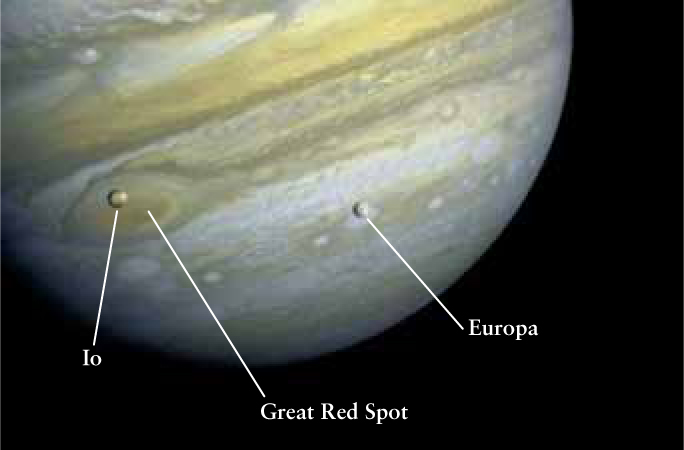13-2 Data from spacecraft reveal the unique properties of the Galilean satellites
Even the finest images made with Earth-based telescopes have revealed relatively few details about the Galilean satellites. Almost everything we know about these satellites has come from observations made at close range by spacecraft.
The first close-range observations of the Galilean satellites were made by the Pioneer 10 and Pioneer 11 spacecraft as they flew past Jupiter in 1973 and 1974. The images from these missions were of relatively low resolution, however, and much more information has come from three subsequent missions. Voyager 1 and Voyager 2 flew past Jupiter in 1979 and recorded tens of thousands of images, one of which is shown in Figure 13-2. The Galileo spacecraft, which made 35 orbits around Jupiter between 1995 and 2003, carried out an even more extensive investigation of Jupiter’s satellites. The Cassini and New Horizons spacecraft also imaged Jupiter on their way to Saturn and Pluto, respectively.

Io and Europa from Voyager 1 Voyager 1 recorded this image of Jupiter and the Galilean satellites Io and Europa in February 1979, when it was 20 million kilometers (12.4 million miles) from the giant planet. The satellites are actually smaller than some of Jupiter’s cloud features, such as the Great Red Spot (see Section 12-3). Voyager 1 and Voyager 2 also recorded many images of the Galilean satellites at closer range.
Measuring Satellite Densities
One key goal of these missions was to determine the densities of the Galilean satellites to very high accuracy. Given the density of a planet or satellite, astronomers can draw conclusions about its chemical composition and internal structure. To find the densities, scientists first determined the satellite masses. They did this by measuring how the gravity of Io, Europa, Ganymede, and Callisto deflected the trajectories of the Voyager and Galileo spacecraft. Given the masses and diameters of the satellites, they then calculated each satellite’s average density (mass divided by volume). Table 13-1 lists our current knowledge about the sizes and masses of the Galilean satellites.
Of the four Galilean satellites, Europa proves to be the least massive: Its mass is only two-thirds that of our Moon. Ganymede is by far the most massive of the four, with more than double the mass of our Moon. In fact, Ganymede is the most massive satellite anywhere in the solar system. In second place is Callisto, with about 1½ times the Moon’s mass.
However, Ganymede and Callisto are not merely larger versions of our Moon. The reason is that both Ganymede and Callisto have very low average densities of less than 2000 kg/m3. By comparison, typical rocks in Earth’s crust have densities around 3000 kg/m3, and the average density of our Moon is 3344 kg/m3. The low densities of Ganymede and Callisto mean that these satellites cannot be composed primarily of rock. Instead, they are probably roughly equal parts of rock and water-ice. Water-ice is substantially less dense than rock, but it becomes as rigid as rock under high pressure (such as is found in the interiors of the Galilean satellites). Furthermore, water molecules are relatively common in the solar system. Enough water would have been available in the early solar system to make up a substantial portion of a large satellite such as Ganymede or Callisto.
Three of the Galilean satellites are made of a mixture of ice and rock; only Io is ice-free
Water-ice, however, cannot be a major constituent of the two inner Galilean satellites. The innermost satellite, Io, has the highest average density, 3529 kg/m3, slightly greater than the density of our Moon. The next satellite out, Europa, has an average density of 3018 kg/m3. Both of these values are close to the densities of typical rocks in Earth’s crust. Hence, it is reasonable to suppose that both Io and Europa are made primarily of rocky material.
The most definitive evidence for water-ice on three of Jupiter’s Galilean satellites has come from spectroscopic observations. The spectra of sunlight reflected from Europa, Ganymede, and Callisto show absorption at the infrared wavelengths characteristic of water-ice molecules. You can see this in Figure 7-4, which compares the spectrum of Europa to the spectrum of water-ice. Europa’s density shows that it is composed mostly of rock, so its ice must be limited to the satellite’s outer regions. Among the Galilean satellites, only Io shows no trace of water-ice on its surface or in its interior.
CONCEPT CHECK 13-2
By using Kepler’s laws on any of the moons orbiting Jupiter, the mass of Jupiter is easily determined from Earth-based observations. Can the masses of Jupiter’s moons be determined from Earth as well?
No. In order to measure the masses of Jupiter’s moons, the gravitational deflection of a spacecraft by these moons had to be measured.